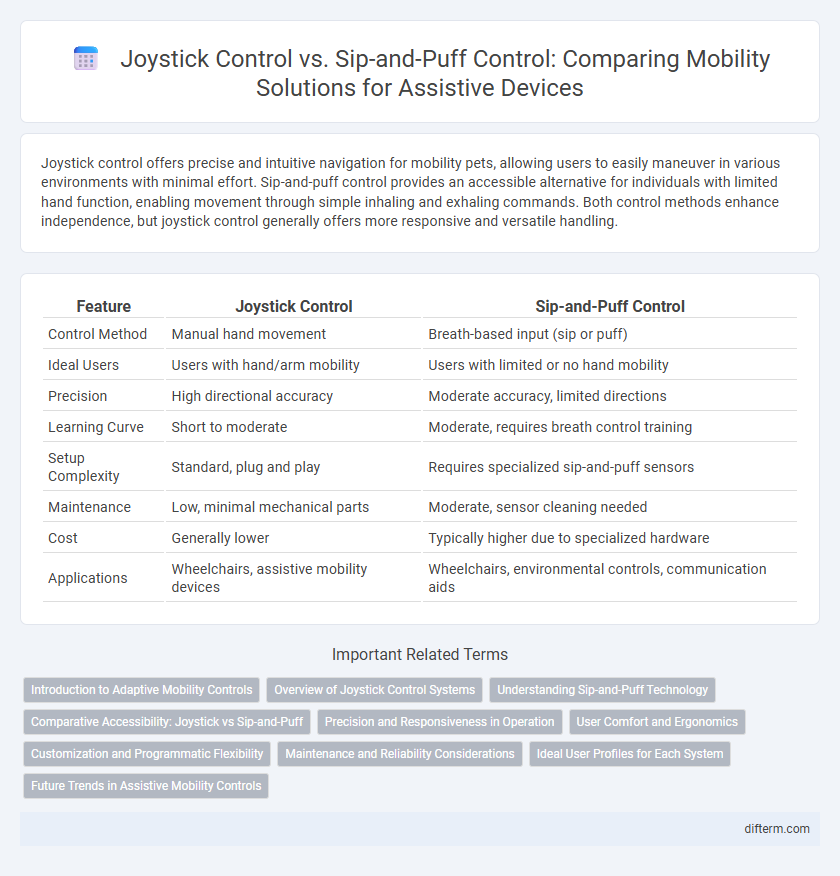Joystick control offers precise and intuitive navigation for mobility pets, allowing users to easily maneuver in various environments with minimal effort. Sip-and-puff control provides an accessible alternative for individuals with limited hand function, enabling movement through simple inhaling and exhaling commands. Both control methods enhance independence, but joystick control generally offers more responsive and versatile handling.
Table of Comparison
| Feature | Joystick Control | Sip-and-Puff Control |
|---|---|---|
| Control Method | Manual hand movement | Breath-based input (sip or puff) |
| Ideal Users | Users with hand/arm mobility | Users with limited or no hand mobility |
| Precision | High directional accuracy | Moderate accuracy, limited directions |
| Learning Curve | Short to moderate | Moderate, requires breath control training |
| Setup Complexity | Standard, plug and play | Requires specialized sip-and-puff sensors |
| Maintenance | Low, minimal mechanical parts | Moderate, sensor cleaning needed |
| Cost | Generally lower | Typically higher due to specialized hardware |
| Applications | Wheelchairs, assistive mobility devices | Wheelchairs, environmental controls, communication aids |
Introduction to Adaptive Mobility Controls
Adaptive mobility controls enhance independence for users with varying physical abilities by providing customized interfaces such as joystick control and sip-and-puff control. Joystick control offers precise maneuverability through hand movement, ideal for users with upper-body strength, while sip-and-puff control allows individuals with limited hand function to navigate mobility devices using breath signals. These adaptive technologies empower users to achieve greater mobility and accessibility tailored to their specific needs.
Overview of Joystick Control Systems
Joystick control systems for mobility devices provide intuitive, multidirectional input, enabling precise navigation and speed adjustment for users with upper body mobility. These systems often feature programmable sensitivity and customizable input modes to accommodate varying levels of dexterity and strength. Advanced joystick controls integrate with electronic wheelchair frameworks, enhancing maneuverability in tight spaces and improving overall user independence.
Understanding Sip-and-Puff Technology
Sip-and-puff technology enables users with limited hand mobility to control devices by inhaling or exhaling into a straw-like apparatus, translating breath pressure into commands. This system offers an alternative to traditional joystick control, providing precise navigation for wheelchair users with high-level spinal cord injuries. Sip-and-puff devices enhance accessibility by converting simple breath inputs into complex directional and functional controls.
Comparative Accessibility: Joystick vs Sip-and-Puff
Joystick control offers precise and intuitive navigation for users with upper limb mobility, enabling fine motor movements for wheelchair operation and device control. Sip-and-puff control provides an accessible alternative for individuals with limited or no hand function, utilizing breath signals to generate commands without requiring physical grip or hand strength. Both systems enhance mobility independence but serve distinct user needs based on specific physical abilities and control preferences.
Precision and Responsiveness in Operation
Joystick control offers high precision and rapid responsiveness through proportional input, allowing users to make smooth, fine-tuned movements with minimal effort. Sip-and-puff control relies on varying air pressure signals, which can introduce slight delays and reduced granularity in input interpretation, impacting the overall immediacy and accuracy. For tasks demanding intricate maneuvering, joystick systems generally provide superior operational precision and responsiveness compared to sip-and-puff interfaces.
User Comfort and Ergonomics
Joystick control offers intuitive hand movement and precise maneuverability, enhancing user comfort through customizable sensitivity and ergonomic grip designs that reduce hand fatigue. Sip-and-puff control benefits individuals with limited hand function by enabling command input via breath, minimizing physical strain and accommodating various head or mouth positions for sustained usability. Both systems prioritize ergonomic considerations, but joystick controls excel in dynamic navigation, whereas sip-and-puff controls provide vital accessibility for impaired motor skills.
Customization and Programmatic Flexibility
Joystick control offers extensive customization options, allowing users to adjust speed sensitivity, directional input, and button functions to fit individual mobility needs. Sip-and-puff control systems provide programmatic flexibility through customizable puff and sip patterns, enabling precise command inputs for users with limited motor skills. Both controls support tailored settings, but sip-and-puff systems excel in accessibility for users requiring hands-free operation.
Maintenance and Reliability Considerations
Joystick controls for mobility devices typically offer straightforward maintenance with easily replaceable parts and fewer susceptibility issues compared to sip-and-puff systems, which rely on sensitive pneumatic sensors prone to clogging and calibration drift. Sip-and-puff controls demand regular cleaning and sensor checks to ensure accurate pressure detection and prevent signal interference that can impact reliability. Consistent upkeep of both systems is crucial, but joystick controls generally present lower long-term maintenance challenges and higher operational reliability in diverse environments.
Ideal User Profiles for Each System
Joystick control suits users with adequate hand dexterity and upper limb strength, enabling precise and responsive maneuvering frequently favored by individuals with spinal cord injuries or amputations. Sip-and-puff control benefits users with limited or no hand function, such as those with high-level quadriplegia, allowing effective wheelchair navigation through inhaling and exhaling signals. Selecting the appropriate system depends on the user's specific motor abilities, respiratory capacity, and overall comfort with the interface.
Future Trends in Assistive Mobility Controls
Future assistive mobility controls are increasingly integrating advanced joystick technologies with adaptive sip-and-puff systems to enhance user precision and accessibility. Innovations in sensor fusion, AI-driven responsiveness, and customizable interfaces are shaping the development of hybrid control solutions that cater to diverse mobility impairments. These emerging trends prioritize real-time adaptability and user-centered design, aiming to improve independence and quality of life for individuals relying on powered mobility devices.
joystick control vs sip-and-puff control Infographic

 difterm.com
difterm.com